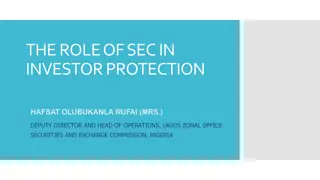Understanding the SEC and Fort Worth Regional Office
The U.S. Securities and Exchange Commission (SEC), established in 1934, plays a crucial role in protecting investors, maintaining market integrity, and facilitating capital formation. Led by five Commissioners, the SEC oversees various entities, including investment advisers, mutual funds, and brokerage firms. With five principal statutory authorities and five key divisions, the SEC works diligently to enforce regulations, ensure compliance, and provide public information. Additionally, the SEC operates through eight offices to cover areas such as compliance, enforcement, and investor education.
Download Presentation

Please find below an Image/Link to download the presentation.
The content on the website is provided AS IS for your information and personal use only. It may not be sold, licensed, or shared on other websites without obtaining consent from the author. Download presentation by click this link. If you encounter any issues during the download, it is possible that the publisher has removed the file from their server.
E N D
Presentation Transcript
Overview of the SEC and the Fort Worth Regional Office 1
Disclaimer Remember: The U.S. Securities and Exchange Commission, as a matter of policy, disclaims responsibility for any private publication or statement by any of its employees. Views expressed herein are those of the presenter and do not necessarily reflect the views of the Commission or other members of the staff of the Commission. 2
Overview of the SEC Created by Congress in 1934 after the Stock Market crash of 1929 The mission is to protect investors, maintain fair, orderly, and efficient markets, and facilitate capital formation Principal Activities: Write rules, regulations, and policies Check for compliance with the rules Take enforcement action if not complying Provide information to the public 3
Overview of the SEC Principal Statutory Authority: Securities Act of 1933 Securities Exchange Act of 1934 Investment Company Act of 1940 Investment Advisers Act of 1940 Sarbanes-Oxley Act of 2000 ( SOX ) Dodd-Frank Wall Street Reform and Consumer Protection Act (2010) 4
Overview of the SEC Run by five Commissioners Chair Mary Jo White Each appointed by the President No more than three commissioners from same party Workforce of 3900 Smaller than the DC police department Oversees 35,000 + entities: 11,700 investment advisers 9700 mutual funds and ETFs 4500 brokerage firms Stock market in which more than 8.5 billion shares are traded each day Financial statements and corporate disclosures for all public companies 5
Overview of the SEC Five Divisions: Corporation Finance Offerings (issuers) Public companies Enforcement All registrants Investment Management Investment Advisers Investment Companies Trading and Markets Broker-Dealers SRO s Transfer Agents Risk, Strategy, and Financial Innovation 6
Overview of the SEC Eight Offices: Compliance, Inspections and Examinations Investor Education and Advocacy Chief Accountant Secretary General Counsel International Affairs Administrative Law Judges Legislative and Public Affairs 7
Overview of the SEC Eleven Regional Offices: New York Boston Philadelphia Denver Fort Worth Salt Lake Chicago Los Angeles San Francisco Miami Atlanta 8
Overview of the SEC Regional Offices two principal activities: Enforcement Director Andrew Ceresney Deputy Director Stephanie Avakian Investor protection Conducts investigative activities and court litigation Compliance, Inspections, and Examination Acting Director Marc Wyatt Carries out the National Examination Program for investment advisers, investment companies, broker-dealers, municipal securities dealers, transfer agents, clearing agencies, self-regulatory organizations, municipal advisors 10
The Fort Worth Regional Office Region covers Texas, Oklahoma, Kansas and Arkansas Fastest growing state and three fastest growing metros in US (Austin, Houston and Dallas) 468 NYSE and Nasdaq companies More than 1,000 public reporting companies 64 Fortune 500 companies (2014 rankings) Three of six largest: Walmart, Exxon Mobil, and Phillips 66 Arkansas (7) has second largest concentration of F-500 in our region, behind Texas 11
The Fort Worth Regional Office 119 Total Employees 66 Enforcement staff 41 Attorneys 10 CPA Accountants 10 paralegals 44 Examination staff 26 IA/IC 12 Broker-Dealer 1 Geophysicist on staff 12
Specialty Units SEC has five specialty units, three of which are represented in FWRO FCPA Asset Management Complex Financial Instruments Municipal Securities Market Abuse 14
Key Features of our Investigations Self-contained: Investigate and litigate our own cases Purely civil jurisdiction Can sue in federal court or administratively Broad investigative powers but key limitations imposed by Privacy Act and other acts Specifically authorized to collaborate with DOJ 15
Types of Cases Financial reporting and disclosure Insider trading FCPA Broker-dealer, investment adviser & investment company Market manipulation Offering frauds & Ponzi schemes Affinity frauds, especially religious affinity Oil & gas offerings Very crude to highly sophisticated 16
Subpoenas Administrative, not court, subpoenas Staff drafts and sends Not self-executing Enforceable through federal court action Not subject to Rules of Civil Procedure 17
Sworn Testimony Usually starts after documents reviewed Similar to depositions, with key differences Staff administers the oath No right to cross-examine FRCP and FRE don t apply No right to receive the written transcript (but usually allowed) Limited attendance 18
Sharing Information SEC can share information with DOJ and other law enforcement. Rule 24c-1 of Exchange Act. Courts have explicitly approved DOJ/SEC collaboration. E.g., US v. Kordel, US v. Stringer Sharing information requires approval of assistant director or above. Sharing documents requires written access request. Under Dodd-Frank Act, we can share privileged materials with other agencies without waiving the privilege. Exchange Act Section 24(f). 19
Enforcement Action Staff drafts recommendation describing the factual and legal bases for bringing case We can and sometimes do share the factual summaries with the USAO and FBI Recommendation reviewed and commented on by HO, including General Counsel s Office and other interested divisions and offices Review intended to promote consistency and solid legal foundation Can be time consuming process 20
Recommending Action to the Commission After action memo vetted by staff, goes to Commissioners Usually considered at closed meeting (i.e. non-public) Can be reviewed quickly and approved by a single Commissioner if an emergency matter Once approved, we file the action Have to return to the Commission for further authority to take certain actions (e.g., settlement, add/drop parties or charges) 21
Federal District Court Emergency Cases ongoing fraud, investor funds at risk Temporary Restraining Order Preliminary Injunction Asset Freeze Receiver takes possession of all documents and things. Can turn over to criminal authorities. Surrender of passport. Expedited Discovery put defendant on the record on 72 hours notice. 22
Federal District Court (contd) Non-Emergency Cases. Injunction against further violations of the securities laws. So-called obey-the-law injunction. Conduct-based injunction. Officer-and-director bar. Penny-stock bar. Disgorgement of any money obtained from the illegal conduct. Civil Penalties. Third-tier: up to $165,000 per violation or amount of pecuniary gain. 23
Federal District Court (contd) Non-Emergency Cases (cont.) But insider trading cases are different. Maximum penalty is 3x the amount of profits gained or losses avoided. SOX 304: restatement due to misconduct (not necessarily by defendant); defendant must reimburse issuer amount of bonus or stock-based compensation received during 12 months following financial misreporting. 24
Administrative Proceedings Post-Dodd Frank can get nearly all same remedies as district court. Cease-and-desist orders. Undertakings procedures to prevent further violations. Bar a firm from acting as a securities firm or an investment adviser, or individual from the securities industry. Rule 102(e): Bar a professional from practice before the Commission. 25
Regional Registrant Demographics Investment Advisers 669 Registered Investment Advisers (6% of all SEC registered advisers) $1.745 trillion in AUM (3% of total AUM of registered advisers) 36% indicate that they manage private funds 42% have custody (including through a related person) 4% are also broker-dealers Broker-Dealers 264 registered BDs (~6% of all SEC registered broker-dealers) 14,003 branch offices (~9% of total) $10 billion in assets 1,007,320 customer accounts held 54,345 associated individuals Other 51 Municipal Advisor Registrants 32 Transfer Agents 27
Examination Process Consists of: 1. 2. 3. 4. 5. Exam Selection Exam Assignment Exam Scope Exam Work Exam Disposition 28
Exam Selection Office of Compliance & Examinations Risk Department in D.C. & Regional Offices Identify firms as High Risk based upon business operations, products, revenues, etc. Identify firms as part of National Sweeps Identify newly registered firms or firms that have never been examined Identify firms through Tips, Complaints, and/or Referrals from other SEC offices, other agencies, or the public Assigned to Regional Offices where firm is located Regional offices select firms from this list 29
Exam Assignment Associate and Assistant Regional Directors break up the firms they have selected (i.e. IA/IC or BD/TA) Exam Managers are then assigned to oversee the completion of the exam Exam Team created based upon knowledge level of products offered or sold by the firm, and staff availability Exam Team consists of: Exam Manager Lead Examiner Supporting/Assisting Examiner(s) depending on size of firm, could be multiple supporting examiners 30
Exam Scope Determining Scope Initially based upon risks identified during selection process May be extremely focused (if TCR, or Sweep) May be pretty broad if firm has never been examined before Scope will identify focus areas for the exam team Focus area can be adjusted during the pre-exam and/or on-site fieldwork stages of the exam. 31
Exam Work Three Stages Pre-Fieldwork Fieldwork (on-site) Post-Fieldwork 32
Pre-Fieldwork Review databases, filings, past examination reports, past enforcement actions, financials, registrations, complaints, etc. Review firm websites, news articles, and any other internet search results related to the firm At this point, we could adjust scope if needed based upon pre-exam review We may also review modules related to the scope or focus areas of the exam (modules are references/guides that aid in performing specific reviews) We may also review no-action letters or any interpretive releases related to any of the focus areas of our scope 33
Pre-Fieldwork (contd) Notify Firm We typically notify the firm during the pre- fieldwork process of the upcoming examination (usually a week to two weeks before the on-site fieldwork begins) During the notification call with the firm, we gather some general info about the firm (business activities, types products sold, number of employees, number of customers, fees charged, etc.) Following the call we send the firm a document request list. 34
Fieldwork We meet on-site with firm personnel and discuss the firm s operations, structure, policies and procedures, and other topics as they may relate to the focus areas of the exam. Remainder of the week is spent reviewing the requested documentation and meeting additional firm personnel. During this stage, we may make additional requests if necessary and review 35
Post Fieldwork Reviews continue back in the office. The exam staff typically spends a few additional weeks finishing reviews, and researching various regulatory issues (securities laws, interpretive guidance, and no-action letters to support any/all findings identified during the exam). Memorialize exam work in an internal exam report. The report typically identifies the focus areas of the exam along with the reviews performed, and any violations of securities laws identified during the exam. 36
Exam Disposition Generally three types of outcomes to an exam: 1. No findings resulting No Further Action Taken (rarest outcome) 2. Deficiency Letter A letter to the firm that identifies all of the areas where we found that the firm failed to comply with Securities Laws. Deficiency Letters require a timely response from the firm regarding corrective action Also, provides opportunity to present facts if they feel our findings are incorrect. 3. The exam is referred to another SEC division or separate agency SEC Enforcement Referral SRO Referral (FINRA, CFTC, etc.) State Securities Board Referral (TSSB) Other SEC Offices or other Divisions (Regional, TM, CorpFin, etc.) 37























